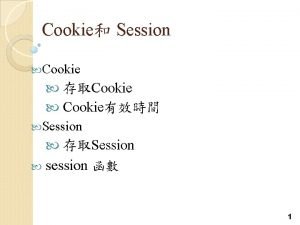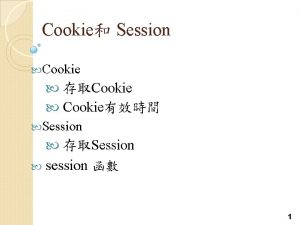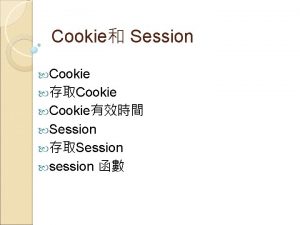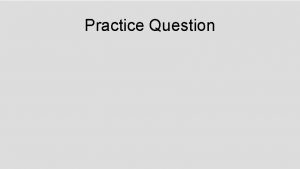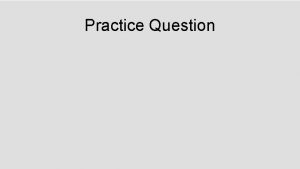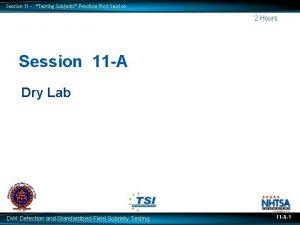Practice session 6 The environment model Environment Model

















- Slides: 17

Practice session #6: The environment model

Environment Model: Introduction Environments: • Frame: GE Maps variables to values (i. e. , every variable in a frame has a single value). x: 3 y: 5 • Environment: A finite linked list of frames, where the last frame is the global environment. • The global environment: A single-frame environment, the only environment that statically exists. • Enclosing environment of E: E, excluding its first frame. II z: 6 x: 7 E 1 I n: 1 y: 2 E 1=<II, I>, E 2=<III, I>, GE=<I> Enclosing-env (E 1) = GE Enclosing-env (E 2) = GE III

Environment Model: Introduction Environments: • The value of variable x in E: GE The value of x in the first frame where it is defined. x: 3 y: 5 II z: 6 x: 7 E 1 I n: 1 y: 2 E 1=<II, I>, E 2=<III, I>, GE=<I> Enclosing-env (E 1) = GE Enclosing-env (E 2) = GE III

Environment Model: Introduction Closure: A complex data structure with: (1) Procedure parameters. (2) Procedure body. (3) The environment at the time it was created. b 1 > (define square (lambda (x) (* x x))) > (lambda (y) y) b 2 GE square: p: (x) b 1: (* x x) p: (y) b 2: y

Environment Model: Introduction Procedure application: (1) Create new frame, mapping the procedure params to application values. (2) The new frame extends the environment associated with the procedure. (3) Evaluate the body of the procedure in the new environment. b 1 > (define square (lambda (x) (* x x))) > (square 5) GE square: p: (x) b 1: (* x x) E 1 b 1 x: 5 GE

Environment Model: Recursion GE fact: p: (n) b: (if…) E 1 b n: 3 GE 6 E 2 b n: 2 E 1 2 E 3 b n: 1 E 2 1 E 4 b n: 0 E 3 1

Environment Model: Definition and Application GE sq: p: (x) b 1: (* x x) sum-of-squares: f: p: (x y) b 2: (+ (sq x) (sq y)) p: (a) b 3: (sum-of-squares (+ a 1) (* a 2))

Environment Model: Definition and Application GE sq: p: (x) b 1: (* x x) sum-of-squares: f: p: (x y) b 2: (+ (sq x) (sq y)) E 1 B 3 GE 136 a: 5 E 2 x: 6 y: 10 B 2 E 1 136 p: (a) b 3: (sum-of-squares (+ a 1) (* a 2)) E 3 x: 6 B 1 E 2 36 E 4 x: 10 B 1 E 2 100

Environment Model: Definition and Let GE a: 8 b: 5 c: 8 f: p: (x y) b 1: (+ x y) E 1 x: 8 y: 8 b 1 GE 16

Environment Model: Definition and Let GE a: 8 b: 5 c: 8 f: p: (x y) b 1: (+ x y) p: E 1 b 2 a: 8 b: 5 c: 3 p: (a b c) b 2: (let…) GE 53 p: (d e) b 3: (f e d) E 2 b 3 E 1 53 d: 13 e: 40 E 3 b 1 x: 40 y: 13 E 2 53

Environment Model: Pair ADT, Lazy implementation GE make-pair: P 1: E 1 b 1 x: 5 y: 10 p: (x y) b 1: (lambda(sel)…) GE p: (sel) b 2: (sel x y)

Environment Model: Pair ADT, Lazy implementation GE make-pair: P 1: E 1 x: 5 y: 10 p: (a b) b 3: a E 2 sel: b 1 b 2 p: (x y) b 1: (lambda(sel)…) GE p: (sel) b 2: (sel x y) GE 5 b 3 E 3 a: 5 b: 10 E 2 5 > (p 1 (lambda (a b) a))

Environment Model: Pair ADT, Lazy implementation GE make-pair: P 1: E 1 p: (x y) b 3: (p 1(lambda…) E 2 b 3 x: 1 y: 2 b 1 x: 5 y: 10 GE p: (first second) b 4: first p: (x y) b 1: (lambda(sel)…) GE p: (sel) b 2: (sel x y) E 3 b 2 E 2 sel: E 4 b 4 first: 5 second: 10 > (let ((x 1) (y 2)) b 3 (p 1 (lambda (first second) first))) b 4

Environment Model: box, set-box!, set! Box: • Required to wrap a variable so it can be accessed and changed, much like pointers. • In the box environment model, it is used to enable mutation (seen in class) • Box is defined by the interface: (box v) - value constructor (box? x) - type predicate (unbox b) - accessor (set-box!) - mutator set! • A way to change the value of an existing variable. For example: > (define x 5) > x 5 > (set! x 80) > x 80 > (set! y 5) Error: cannot set variable before its definition

Environment Model: set! vs set-box! Example 1: counter (set! vs set-box!) (define counter (let ((count 0)) (lambda () (set! count (+ count 1)) count))) > (counter) 1 > (define count 5) > (counter) 2 E 1 count: 0 1 GE counter (lambda () (set!. . . P = count B = (lambda () (set!. . . o count is the local state of the counter object. 15 E 2 (set! count. . . P= B = (set! count. . .

Environment Model: set! vs set-box! Example 1: counter (set! vs set-box!) > (counter (lambda(x) (set! x (+ x 1)))) 0 (define counter (let ((count 0)) (lambda (modifer) (modifer count))) GE counter E 1 count: 0 (lambda (modifier). . . P=x B = (set! x. . . E 3 x: 0 1 (set! x. . . 16 P = count B = (lambda (modifier). . . E 2 modifier (modifier count)… P = modifier B = (modifier count)…

Environment Model: set! vs set-box! Example 1: counter (set! vs set-box!) > (counter (lambda(x) (set-box! x (+ (unbox x) 1)))) 1 > (counter (lambda(x) (set-box! x (+ (unbox x) 1)))) 2 (define counter (let ((count (box 0))) (lambda (modifer) (modifer count) (unbox count)))) GE counter E 1 count: (lambda (modifier). . . P=x B = (set-box! x. . . E 3 x: (set-box! x. . . 17 P = count B = (lambda (modifier). . . 01 E 2 modifier (modifier count)… P = modifier B = (modifier count)…
 Hình ảnh bộ gõ cơ thể búng tay
Hình ảnh bộ gõ cơ thể búng tay Slidetodoc
Slidetodoc Bổ thể
Bổ thể Tỉ lệ cơ thể trẻ em
Tỉ lệ cơ thể trẻ em Chó sói
Chó sói Chụp phim tư thế worms-breton
Chụp phim tư thế worms-breton Bài hát chúa yêu trần thế alleluia
Bài hát chúa yêu trần thế alleluia Các môn thể thao bắt đầu bằng tiếng bóng
Các môn thể thao bắt đầu bằng tiếng bóng Thế nào là hệ số cao nhất
Thế nào là hệ số cao nhất Các châu lục và đại dương trên thế giới
Các châu lục và đại dương trên thế giới Công thức tiính động năng
Công thức tiính động năng Trời xanh đây là của chúng ta thể thơ
Trời xanh đây là của chúng ta thể thơ Mật thư tọa độ 5x5
Mật thư tọa độ 5x5 Làm thế nào để 102-1=99
Làm thế nào để 102-1=99 độ dài liên kết
độ dài liên kết Các châu lục và đại dương trên thế giới
Các châu lục và đại dương trên thế giới Thể thơ truyền thống
Thể thơ truyền thống Quá trình desamine hóa có thể tạo ra
Quá trình desamine hóa có thể tạo ra






















